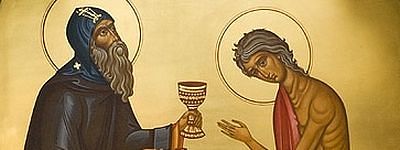

| Previous day | Next day |
| Old Style
March 21
|
Thursday |
New Style
April 3
|
|
5th Week of Great Lent.
Tone 7.
Great Lent. |
Wine and oil allowed.
|
The Great Canon of St. Andrew of Crete.
![]() St. James the Confessor, bishop, of the Studion (8th c.-9th c.). St. Seraphim of Vyritsa (1949).
St. James the Confessor, bishop, of the Studion (8th c.-9th c.). St. Seraphim of Vyritsa (1949).
St. Cyril, bishop of Catania (1st c.-2nd c.). St. Thomas, patriarch of Constantinople (610). St. Pachomius, abbot, of Nerekhta (1384).
St. Beryllus, bishop of Catania (2nd c.). St. Serapion, bishop of Thmuis, Egypt (ca. 358). St. Lupicinus, desert-dweller, of the Jura Mountains (Gaul) (480). St. Enda, monk, of Aran (Ireland) (530). St. Sophronius, abbot, of the monastery of St. Theodosius in Palestine (542). New Martyr Michael of Agrapha, at Thessalonica (1544). Martyrs Philemon and Domninus of Rome. St. Serapion the Sindonite, monk, of Egypt (5th c.).
Thoughts for Each Day of the Year
According to the Daily Church Readings from the Word of God
By St. Theophan the Recluse

Thursday.
A haughty spirit goeth before a fall (Prov. 16:18).[1] Therefore, do not allow evil thoughts to come in, and there will be no falls. And yet what are people most careless about? About their thoughts. They allow them to seethe as much and however they like, not even thinking to subdue them, or to direct them to rational pursuits. Meanwhile, within this inner turmoil the enemy approaches, places evil in the heart, seduces it and inclines it toward evil. And the person unnoticeably prepares himself for evil. It remains for him to either carry out the evil fixed to his heart, or to struggle with it. But this is our sorrow: that almost nobody takes on the struggle; while all are led to the evil as if bound.
[1] The Slavonic for Prov. 16:18 reads: Evil thoughts go before a fall. Probably St. Theophan used the Slavonic version as he wrote, but the editor used the Russian version, and so the editor added the words, “evil thoughts” in parentheses in my version of the text).
Articles
 Thursday of the Great Canon |
 St. James the Confessor the Bishop of CataniaSaint James, Bishop and Confessor,was inclined toward the ascetic life from his early years. |
 St. Cyril the Bishop of CataniaSaint Cyril was born in Antioch. He was a disciple of the Apostle Peter (June 29, January 16), who installed him as Bishop of Catania in Sicily. |







